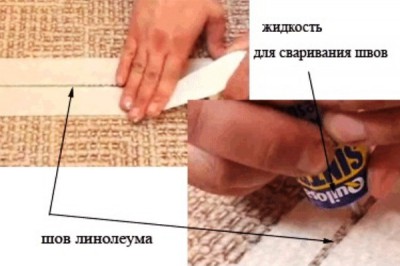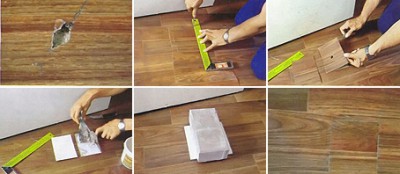Is it possible to put linoleum on linoleum: we solve the urgent dilemma
Simplicity and speed of installation are recognized by one of the most attractive aspects of a democratic floor covering, both decorators and inexperienced in the field of repair. Not that I was drawn to change linoleum after a change of mood, but such interior updates will not become burdens for the family budget. The floor plane “didn’t fit” into the overall composition, and it asks for a replacement, but questions about whether to remove the old finish or not need to torment it, you can put linoleum on linoleum or not. None of the questions posed by the owner, perplexed by the laboriousness of dismantling, has a clear answer. It all depends on the condition of the floor and its ability to serve as a basis for a new coating.
To remove or not to remove the old linoleum?
If the old worn floor, which had “seen the appearance” even before the collapse of the Soviet empire, “bubble” under your feet, all doubts must be rejected and with a ruthless hand destroyed this hereditary “relic”.
- Dust. In that distant time, linoleum was produced on a not-so-reliable fabric basis, which, over the years of intensive use, was probably destroyed and rotted. Even if the owners all these years walked along the plinth, protecting the floor surface from loads, dust accumulated in the fabric base spread by the materials of the floors, separated particles of the fabric itself and ancient glue. Without a doubt, there are few people who want to breathe this mixture.
- Mud. Ancient linoleum without a base also probably accumulated enough dust, waste products of bacteria and dirt in its seams.
- Peeling from the rough base. Identification of this gender defect more convincingly than other reasons argues for the removal of old linoleum. There can no longer be any discussion on the topic “can linoleum be laid on linoleum”. The floor covering with problem areas needs to be removed, the worn-out rough surface repaired, after which it is best to fill in a fresh screed.
- Uneven surface. This is the most compelling reason for the complete extermination of old linoleum. If there are waves, holes, dents on the surface, any defects creating a relief, it is better to remove the coating. According to technical regulations developed for all types of floor coverings, the maximum deviations from the perfect horizontal in any vector direction should not exceed 1-2 mm per two meters of area.
An uneven surface is a serious obstacle even for those who decide to lay a PVC tile over linoleum. Do not rely on a large number of seams and bright colors of the elements, visually, supposedly, masking potholes and ridges.
It is possible that the elastic material will even more highlight the unsightly causes, decorated by such a simple method. Before you put the tile on linoleum, you will have to prepare the surface using standard methods regulated by technical standards.
To facilitate the dismantling of old linoleum, firmly glued to the rough basis, will help cutting the coating into separate strips. Removing the strip will not be as difficult as a large sheet. Separate linoleum with a spatula or scraper. Sometimes they use a special jack scraper and a tear-off grab. Sometimes dismantling is possible only with the help of an electric mill and a grinder.
There is still an argument convincing to remove the rough old linoleum. In areas with dents and waves, the coating will wear out more due to differences in loads. Moreover, it is unlikely that it will be pleasant and safe to move around on the floor, which has thoroughly repeated all the features of a far from ideal imperial predecessor. It is doubtful that it will give visual pleasure and will not “beg” for a new repair.
What to do with recently laid linoleum?
There is no reason to clean it if the base floor was perfectly aligned before installation and there is absolutely no desire to mess around with a coating firmly glued over the entire area of the room. And it will not be easy to remove it, and there will be a lot of dirt. Yes, and the point is to shoot perfectly laid linoleum, no. It will be an excellent insulating layer for the flooring of the finishing material and a leveling element, reducing labor costs and wasting valuable time for the production of this operation, which is obligatory for finishing floors.
Important. If it is planned to lay new linoleum on an analogue laid earlier, the finish layer should be without a base.
The general procedure is as follows:
- Before gluing, the floor in the equipped room must be prepared: remove all dust, specks, dirt, degrease the surface and dry. Humidity in the trimmed room should not exceed the limit of 65%. The optimum temperature is 18º C, laying production up to 24º C is permissible.
- Before laying the linoleum, installed horizontally in rolls, you need to stand in the equipped room for two days.
- Then the coating is cut directly on the object. Linoleum can be opened in the store according to the sizes submitted by the buyer. Cutters need to provide maximum values for the length and width of the room, it is advisable to make a plan with the location of risers, plumbing, doorways.
- Then the material is spread on the surface of the floor and another day waiting for geometric changes from it: smoothing the waves, changing linear dimensions.
- Bonding of linoleum to linoleum is carried out by standard methods, which can be read about in the relevant articles. For fixing the baseless coating, an adhesive tape or special mastic with a rubber base and a mixture of synthetic resins is suitable.
It is recommended to lay one sheet of material on the floor, trying to eliminate seams. But if this circumstance could not be avoided, the seams must be connected cold welding.
Linoleum, fixed with a tape with adhesive surfaces on both sides, is laid taking into account the technological gap distributed throughout the contour of the room. A distance of 1-2 cm closed by the baseboard will provide a "bridgehead" for the movements occurring with linoleum from an increase in temperature. The material does not wake up, the waves will not appear on it.
Solving the issue and video with an example of styling
The far from idle question of whether linoleum can be laid on linoleum has good reasons. It is very difficult to remove the coating that is firmly attached to the subfloor throughout the entire area. Dust, caustic construction waste, a lot of time spent also do not particularly attract the owners. Qualitatively laid linoleum, but boring or not liked by the owners, you can not remove. You need to remove the old linoleum without hesitation for a second.








12 comments